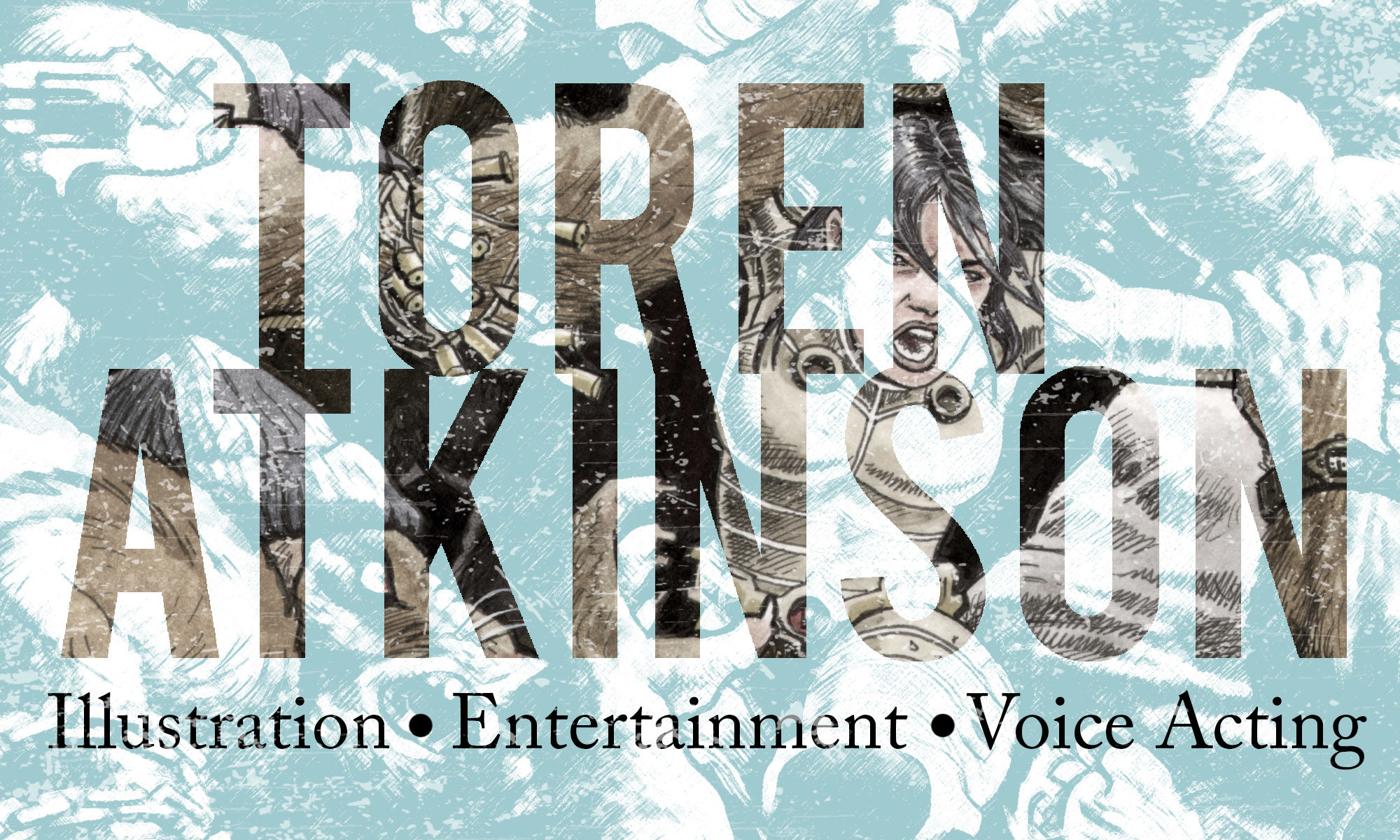
Hi! I’m Toren Atkinson! In addition to being a Dungeon Master and an illustrator for D&D and other RPGs, I’m also a professional voice actor! I’ve done voices for video games, cartoons and commercials.
While voice acting is not necessary to be a good DM (or player), I think we can all agree it adds a lot to keep characters lively and memorable. But I’ve heard a lot of people say that they just can’t do voices. And to that I say – you can! And I’m here to help!
UPDATE! This post has inspired a video which you can watch here:
Let me tell you my secret: If you’re like me, you’ve got a notebook that you bring with you to your gaming sessions. In my own notebook – on the last page (the back inside cover, in fact) – I have a list of character voices that I am comfortable with (I’ve included it below). Every time I need a new non-player character to interact with the players, I flip to that page and pick a voice that’s suitable, and when I’m not in the thick of roleplay, I’ll remember to make a note beside that voice as to which character it belongs to, so that if the players come across that NPC again, I can refer to the list and keep things consistent. Some of the voices are impressions of celebrities or existing film & TV characters, while others use broad accents or my own repertoire of character voices.
“But Toren,” you say, “I’m not a professional voice actor. I can’t do impressions or accents!”
There are a lot of ways to provide vocal character without doing accents or impressions. Let’s say you’ve got an English noble character, but you can’t do a British accent to save your life! Well, you can try to simply use refined, proper diction. It helps if you literally look down your nose at your players while doing so. Conversely, for a lowlife dock monkey, slurring your words and talking in slang, with every second word a profanity can absolutely get a great character across (for added fun, they don’t have to be offensive or modern curse words)
You can change your cadence – maybe someone speaks super quickly with run-on-sentences, with eyes darting and face twitching. Or, they speak robotically with the same emphasis of every syllable. Or portray the always bored and/or “too cool for school” cynic – who speaks in slowly and monotone, like Daria or the teacher from Ferric Bueller’s Day Off (“Bueller…Bueller…Bueller…”). Perhaps an old shell-shocked veteran speaks softly while staring into the middle distance. Another character speaks only in whispers, but they do so with wild enthusiasm. You can whisper, can’t you? Meanwhile there’s that guy who doesn’t have an ‘inside voice,’ always talking to you as if you’re on the other side of the street. And how about the character who is chronically constipated, with the strain coming through in their voice?
An old voice actors trick is to actually change your voice by physically interacting with your face, whether it be holding your nose, pulling your cheek out with a finger, or whathaveyou.
Don’t overstay your welcome.
For throwaway NPCs a strident or grating voice can be amusing and memorable, but for main NPCs that the players will see over and over, I recommend not going over the top. Nobody wants to hear your Gilbert Gottfried or Elmo impression for 3 hours.
It needs to be said: avoid offensive caricatures. My rule is if a player of a minority was at my table (let’s say a South Asian) and I did a stereotypical caricature of that minority (Apu, for example), would I feel weird? If the answer is yes – don’t do it. This goes for sexual preference and those with any kind of disability as well. Your mileage may vary.
And as always, be mindful of others within earshot of your game. After overusing ‘shouty guy’ in your friends living room you may find you no longer have a place to play.
This is the list that I use. I hope that it will inspire you to try something new next session!
Stereotypical Brooklyn guy
Stereotypical Canadian guy, eh? (McKenzie Brothers)
Stereotypical Scandinavian
Stereotypical Russian
Stereotypical Australian/Steve Irwin/Bruce
Stereotypical Italian/Mario
Yarrrr stereotypical pirate voice
Edward G Robinson
James Mason
Alec Guinness
Wolfman Jack
Sir Ian McKellan
David Attenborough
Dracula (Bela Lugosi)
Tim Curry
Tom Waits/Nick Nolte
Jason Statham/Ray Winstone
Christopher Lloyd
Tracy Morgan
Billy Connolly
Inigo Montoya
Charlton Heston
Lennie from Mice and Men (“I will call him George”) AKA Patrick Star
Bane
Bjork
Emperor Palpatine
Dustin Hoffman
Ricardo Montalban
Christopher Walken
Christoff Walz
Kennedy/Mayor Quimby
Morgan Freeman
Jay Baruschel
Jerry Lewis/Professor Frink
Marlon Brando
Beavis/Butthead
Montgomery Burns
Transatlantic accent
Elvis
Watto (Star Wars)
Ed Wynn (Mad Hatter/Mayor McCheese)
Brian Blessed/John Rhys-Davies
Jesse Ventura
Bob Dylan
Kermit the Frog
Hagrid (Harry Potter)
Chris Rock
Wallace Shawn
Jack Nicholson
Clint Eastwood
Sean Bean
Korg (Taika Waititi)
Harvey Fierstein
Drunken Dudley Moore
Thurston Howell the 3rd
Samuel L Jackson
Cobra Commander
William Shatner/Zap Brannigan
Gomer Pyle
Will Arnett
Grimlock (Transformers)
Jimmy Stewart
Maude Flanders/Fargo
Alice Glick/Maude Frickert/Old Lady
Monty Python old British lady
Teen with Cracking Voice
Fat Albert
Hank Hill
Boomhauer (King of the Hill)
Al Pacino
Owen Wilson
Jack Sparrow
Michael Caine
Aku/Mako
Robin Leach
Hippie surfer dude
Caesar with lisp (Life of Brian)
Ozzy Osbourne
Comic Book Guy (Simpsons)
Cletus the Slack-Jawed Yokel (Simpsons)
Doctor Girlfriend (Venture Bros)
Red Skull
Agent Smith/Hugo Weaving
Alan Rickman
Ahnold
Raphael (Sarcastic clerk from The Simpsons)
Humphrey Bogart
Tony Clifton
Peter Lorre
Jack Palance
Marvin the Martian
Lumpy Space Princess (Adventure Time)
Southern Belle/Tree Trunks (Adventure Time)
Mayor of Townsville (Powerpuff Girls)
Werner Herzog







You must be logged in to post a comment.